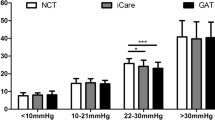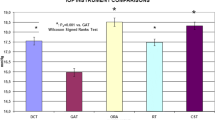Abstract
Introduction and aim
To compare intraocular pressure (IOP) measurements obtained with non-contact tonometry (NCT), Icare rebound tonometry (IRT) and Goldmann applanation tonometry (GAT) in pediatric cases and to examine the effect of topical anesthesia on measurements obtained using IRT.
Materials and methods
Pediatric cases in a healthy general condition and with ophthalmic examination findings within normal limits were included in the study. IOP measurements were taken with NCT and IRT devices in all cases. Topical anesthesia was subsequently applied, and IOP measurements were then repeated using IRT and GAT tonometer devices. Differences between measurements were subjected to statistical analysis.
Results
One hundred ten eyes of 55 patients, 27 male, with a mean age of 11.44 ± 2.31 years (7–17) were included. Mean pre-anesthesia IOP values were 16.47 ± 2.89 mmHg with NCT and 17.49 ± 2.57 mmHg with IRT. Mean IOP values after topical anesthesia were 16.91 ± 2.17 mmHg with IRT and 15.51 ± 2.41 mmHg with GAT. IOP measurement values obtained with all three devices exhibited positive correlation with central corneal thickness values. Statistically significant correlation was present in terms of IOP measurement values between all three devices. However, IOP values obtained with the three devices exhibited statistically significant differences. The application of topical anesthesia caused a statistically significant decrease in IRT measurements; however, statistically significant this small change (0.58 mmHg) in recorded IOP would not be considered clinically significant.
Conclusion
IOP measurements obtained with NCT, IRT and GAT devices in the pediatric age group correlate with one another, but differ from one another in a statistically significant manner. Application of topical anesthesia affects IRT measurements; however, these small changes would not be considered clinically significant.





Similar content being viewed by others
References
Heijl A, Leske MC, Hyman L et al (2002) Reduction of intraocular pressure and glaucoma progression: results from the early manifest glaucoma trial. Arch Ophthalmol 120(10):1268–1279
Leske MC, Heijl A, Hussein M et al (2003) Factors for glaucoma progression and the effect of treatment: the early manifest glaucoma trial. Arch Ophthalmol 121(1):48–56
Group CN-TGS (1998) Comparison of glaucomatous progression between untreated patients with normal-tension glaucoma and patients with therapeutically reduced intraocular pressures. Am J Ophthalmol 126(4):487–497
Kao SF, Lichter PR, Bergstrom TJ et al (1987) Clinical comparison of the OculabTono-Pen to the Goldmann applanation tonometer. Ophthalmology 94:15411544
Eraslan M, Çerman E, Sümmen S (2017) Comparison of intraocular pressure measurements in healthy pediatric patients using three types of tonometers. Turk J Ophthalmol 47:1
Cook JA, Botello AP, Elders A et al (2012) Systematic review of the agreement of tonometers with Goldmann applanation tonometry. Ophthalmology 119:1552–1557
Tamçelik N, Atalay E, Cicik E et al (2015) Comparability of Icare pro rebound tonometer with Goldmann applanation and noncontact tonometer in a wide range of intraocular pressure and central corneal thickness. Ophthalmic Res 54(1):18–25
Recep OF, Hasiripi H, Çağil N et al (2001) Relation between corneal thickness and intraocular pressure measurement by noncontact and applanation tonometry. J Cataract Refract Surg 27(11):1787–1791
Farhood QK (2013) Comparative evaluation of intraocular pressure with an air-puff tonometer versus a Goldmann applanation tonometer. ClinmOphthalmol 7:23–27
García-Resúa C, Pena-Verdeal H, Miñones M et al (2013) Reliability of the non-contact tono-pachymeter Tonopachy NT-530P in health yeyes. Clin Exp Optom 96:286–294
Ogbuehi KC (2006) Assessment of the accuracy and reliability of the Topcon CT80 non-contact tonometer. Clin Exp Optom 89:310–314
Feng CS, Jin KW, Yi K et al (2015) Comparison of intraocular pressure measurements obtained by rebound, noncontact, and Goldmann applanation tonometry in children. Am J Ophthalmol 160:937–943
Flemmons MS, Hsiao YC, Dzau J et al (2011) Icare rebound tonometry in children with known and suspected glaucoma. J AAPOS 15(2):153–157
Sahin A, Basmak H, Niyaz L et al (2007) Reproducibility and tolerability of the ICare rebound tonometer in school children. J Glaucoma 16(2):185–188
Pakrou N, Gray T (2008) Clinical comparison of the Icare tonometer and Goldmann applanation tonometry. J Glaucoma 17:43–47
Brusini P, Salvetat ML, Zeppieri M (2006) Comparison of ICare tonometer with Goldmann applanation tonometer in glaucoma patients. J Glaucoma 15:213–217
Iliev ME, Goldblum D, Katsoulis K et al (2006) Comparison of rebound tonometry with Goldmann applanation tonometry and correlation with central corneal thickness. Br J Ophthalmol 90(7):833–835
Almubrad TM, Ogbuehi KC (2007) Clinical investigation of the effect of topical anesthesia on intraocular pressure. Clin Ophthalmol 1:305–309
Montero JA, Ruiz-Moreno JM, Fernandez-Munoz M et al (2008) Effect of topical anesthetics on intraocular pressure and pachymetry. Eur J Ophthalmol 18(5):748–750
Dosunmu EO, Marcus I, Tung I et al (2014) The effect of repeated measurements and the use of topical anesthetic on rebound tonometry values in children. J AAPOS 18(6):619–621
Yılmaz I, Altan C, Aygıt DE et al (2014) Comparison of three methods of tonometry in normal subjects: goldmann applanationmtonometer, non-contact airpuff tonometer and Tono-PenXl. Clin Ophthalmol 8:1069–1074
Salim S, Linn DJ, Echols JR II et al (2009) Comparison of intraocular pressure measurements with the portable PT100 noncontact tonometer and goldmann applanation tonometry. Clin Ophthalmol 3:341–344
Gao F, Lıu X, Zhao Q et al (2017) Comparison of the icare rebound tonometer and the Goldmann applanation tonometer. Exp Therap Med 13:1912–1916
Kato Y, Nakakura S, Matsuo N et al (2018) Agreement among Goldmann applanation tonometer, iCare, and Icare PRO rebound tonometers; non-contact tonometer; and Tonopen XL in healthy elderly subjects. Int Ophthalmol 38(2):687–696
Güler M, Bilak Ş, Bilgin B et al (2015) Comparison of intraocular pressure measurements obtained byIcare PRO rebound tonometer, Tomey FT-1000 noncontact tonometer, and Goldmann applanationtonometer in healthy subjects. J Glaucoma 24(8):613–618
Grigorian F, Grigorian AP, Li A et al (2015) Comparison of the Icare rebound tonometry with the Goldmann applanation tonometry in a pediatric population. J AAPOS 19(6):572–574
Martinez-de-la-Casa JM, Jimenez-Santos M, Saenz-Frances F et al (2011) Performance of the rebound, noncontact and Goldmann applanation tonometers in routine clinical practice. Acta Ophthalmol 89(7):676–680
Rao A, Kumar M, Prakash B et al (2014) Relationship of central corneal thickness and intraocular pressure by icare rebound tonometer. J Glaucoma 23(6):380–384
Moreno-Montañés J, Gosende I, Caire J et al (2011) Comparation of the new rebound tonometer IOPen and the Goldmanntonometer, and their relationship to corneal properties. Eye (Lond) 25(1):50–56
Burdová MC, Ferrová K, Filous A et al (2011) Correlation of intraocular pressure measured by applanation tonometry, noncontact tonometry and Tonopen with central corneal thickness. CeskSlov Oftalmol 67(5–6):154–157
Author information
Authors and Affiliations
Corresponding author
Ethics declarations
Conflict of interest
The authors report no conflicts of interest. The authors alone are responsible for the content and writing of this article.
Ethical approval
Approval of the Institutional Review Board (IRB). The study was approved by Karadeniz Technical University, Faculty of Medicine, Ethic Council on 2018/20.
Additional information
Publisher's Note
Springer Nature remains neutral with regard to jurisdictional claims in published maps and institutional affiliations.
Rights and permissions
About this article
Cite this article
Uzlu, D., Akyol, N., Türk, A. et al. A comparison of three different tonometric methods in the measurement of intraocular pressure in the pediatric age group. Int Ophthalmol 40, 1999–2005 (2020). https://doi.org/10.1007/s10792-020-01375-8
Received:
Accepted:
Published:
Issue Date:
DOI: https://doi.org/10.1007/s10792-020-01375-8




